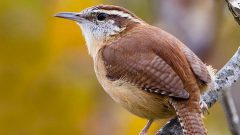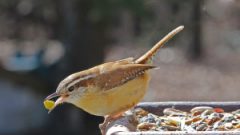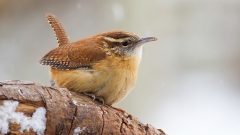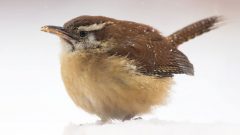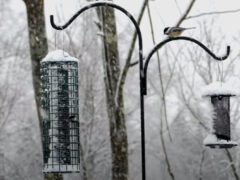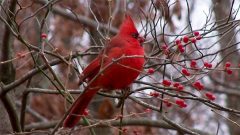Carolina Wren Similar Species Comparison
Main SpeciesCarolina Wren
Adult
Reddish-brown upperparts contrast with buffy underparts and white throat and eyebrow. Wings and tail have bold darker barring, and bill is long and thin.
© Don Danko / Macaulay LibraryOhio, December 26, 2019Adult
Both males and females are a bright, unpatterned reddish-brown above and warm buffy-orange below, with a long white eyebrow stripe, dark bill, and white chin and throat.
© Patrick Maurice / Macaulay LibraryGeorgia, February 13, 2020Male
A small but chunky bird with a round body and a long tail that it often cocks upward. Both males and females are a bright, unpatterned reddish-brown above and warm buffy-orange below, with a long white eyebrow stripe. Only males sing.
© Daniel Jauvin / Macaulay LibraryQuebec, October 06, 2021Adult
The loud, cheerful song is often heard before the bird is seen.
© Chris Thomas / Macaulay LibraryNew Jersey, February 11, 2017Adult
Often found in brushy thickets in wooded residential areas.
© Ryan Schain / Macaulay LibraryMassachusetts, November 20, 2010Male
Males sing a series of several quick, whistled notes, repeated a few times. The notes usually sound three-parted, as in "tea-kettle-tea-kettle" or "germany-germany."
© Larry Arbanas / Macaulay LibraryTexas, April 25, 2008Adult
Sensitive to cold weather, with northern populations decreasing markedly after severe winters. Gradually increasing winter temperatures over the last century may have been responsible for the northward range expansion seen in the mid-1900s.
© Linda Chittum / Macaulay LibraryVirginia, December 21, 2013Adult
Individuals often perch bent over, holding their tails cocked.
© Scott Martin / Macaulay LibraryMassachusetts, March 12, 2017Adult
Forages fairly low in thick tangles of shrubs and vines; also on the ground.
© DAVID BROWN / Macaulay LibraryNew York, October 01, 2004Adult
Visits feeders, especially during the colder months.
© P Smith / Macaulay LibraryPennsylvania, January 14, 2017Adult (White-browed)
Individuals from southern Mexico and Central America are dingy white below with cold brown upperparts.
© John van Dort / Macaulay LibraryCholuteca, October 11, 2019Adult
Note long, curved bill, strong white eyebrow stripe, and rich cinnamon underparts. Often holds tail cocked upward.
© Matthew D. Medler / Macaulay LibraryNew York, November 27, 2014Adult (White-browed)
The "White-browed" group, found from the Yucatan Peninsula to northern Nicaragua, is sometimes treated as a separate species.
© John van Dort / Macaulay LibraryCholuteca, October 15, 2019Adult
Found in dense woodlands and shrubby habitats.
© Elizabeth Anderegg / Macaulay LibrarySouth Carolina, May 01, 2017Similar SpeciesNorthern House Wren
Adult/immature
Northern House Wrens are smaller, darker brown, and shorter tailed than Carolina Wrens. They also lack the white chest and eyebrow stripe of Carolina Wrens.
© Andy Witchger / Macaulay LibraryMinnesota, May 03, 2017Similar SpeciesBewick's Wren
Adult/immature
Bewick’s Wrens are a grayer, longer-tailed western counterpart of the Carolina Wren. Where they overlap in the central U.S., look for the more subdued coloration of Bewick’s Wren compared with the warm buffy or reddish-brown of the Carolina Wren.
© Marlene Cashen / Macaulay LibraryWashington, March 04, 2017Don't miss a thing! Join our email list
The Cornell Lab will send you updates about birds,
birding, and opportunities to help bird conservation.













